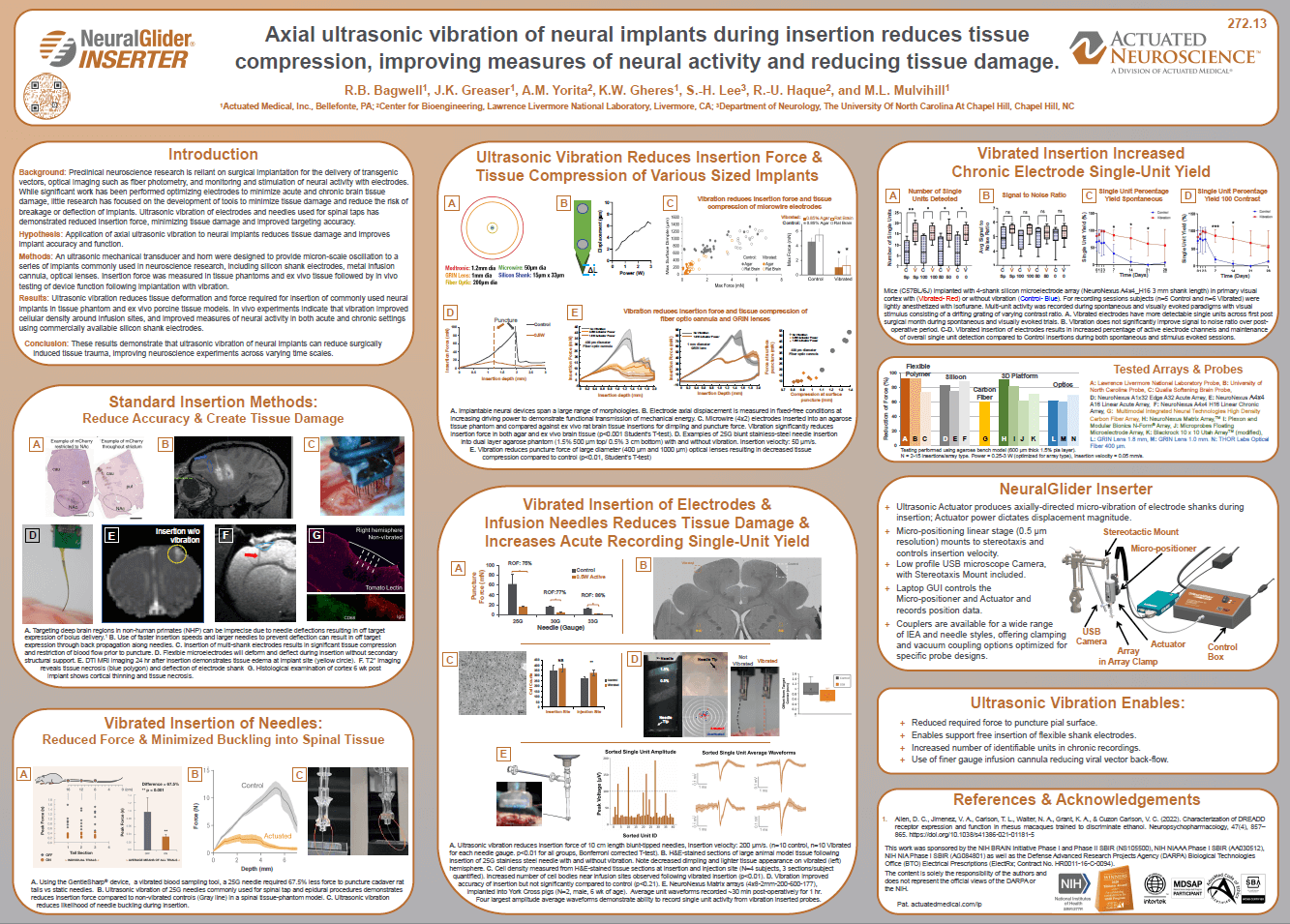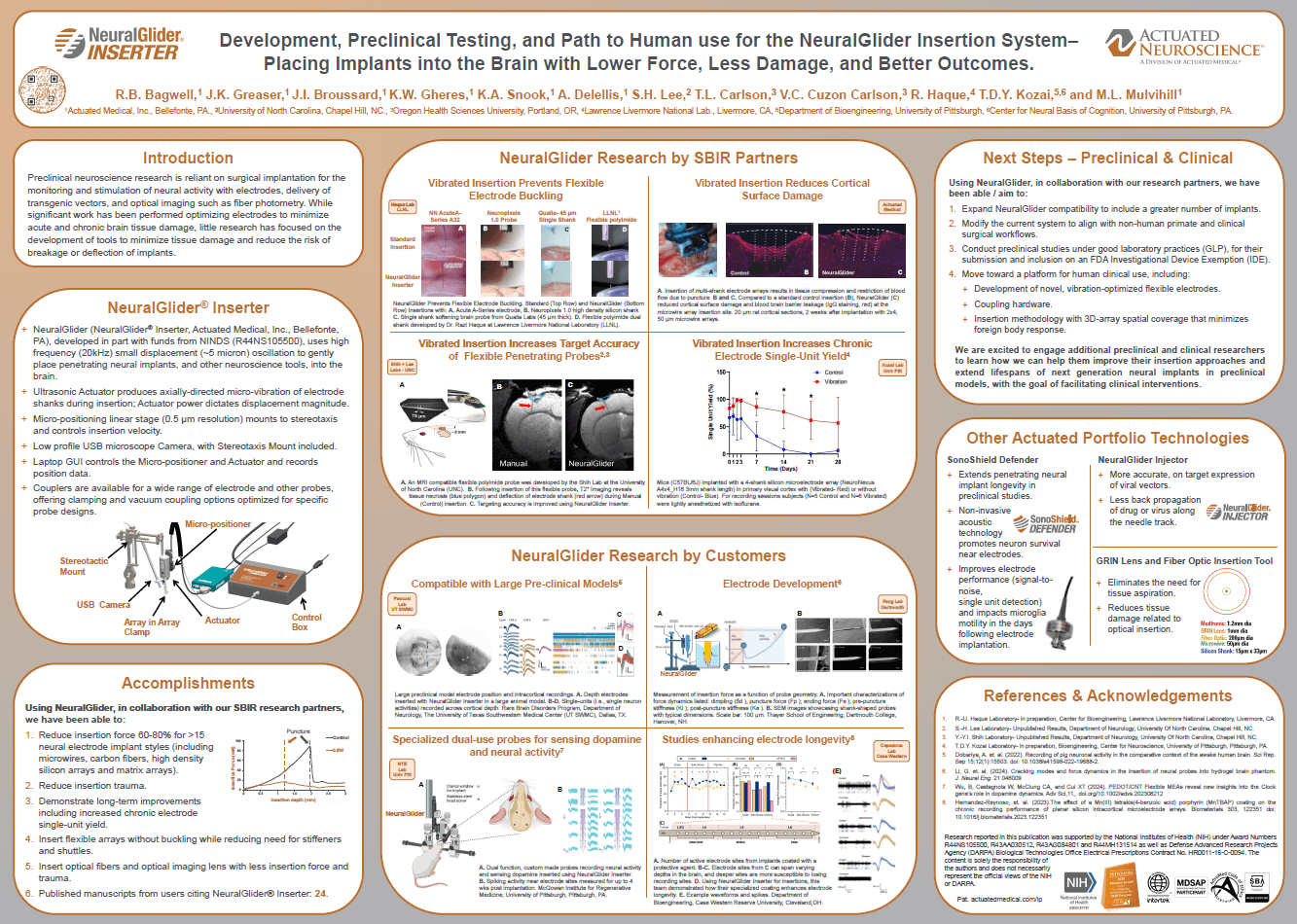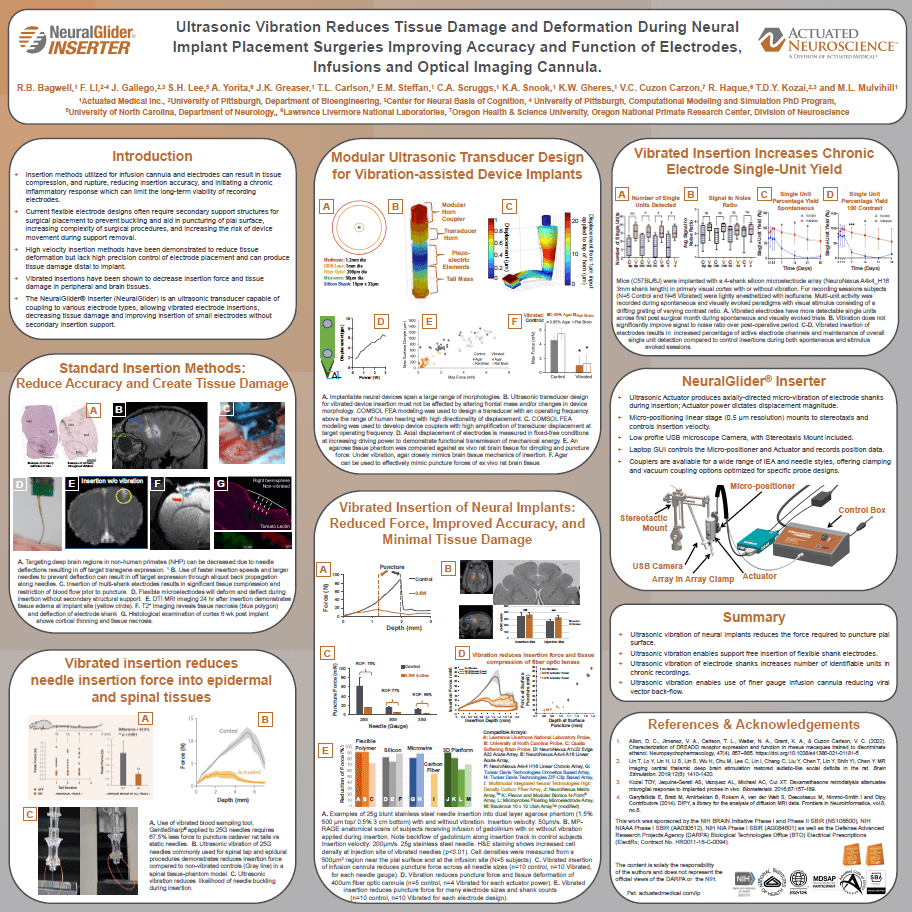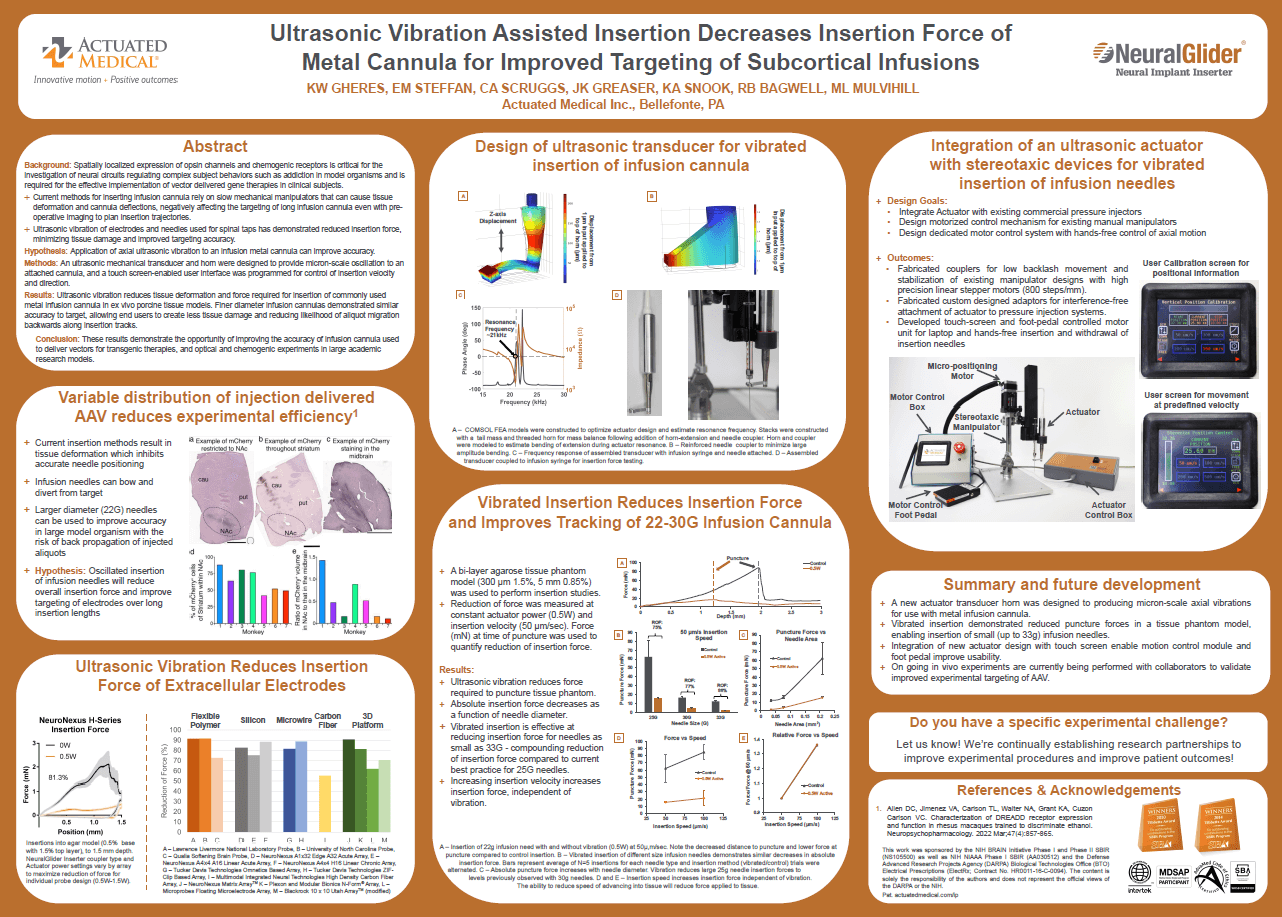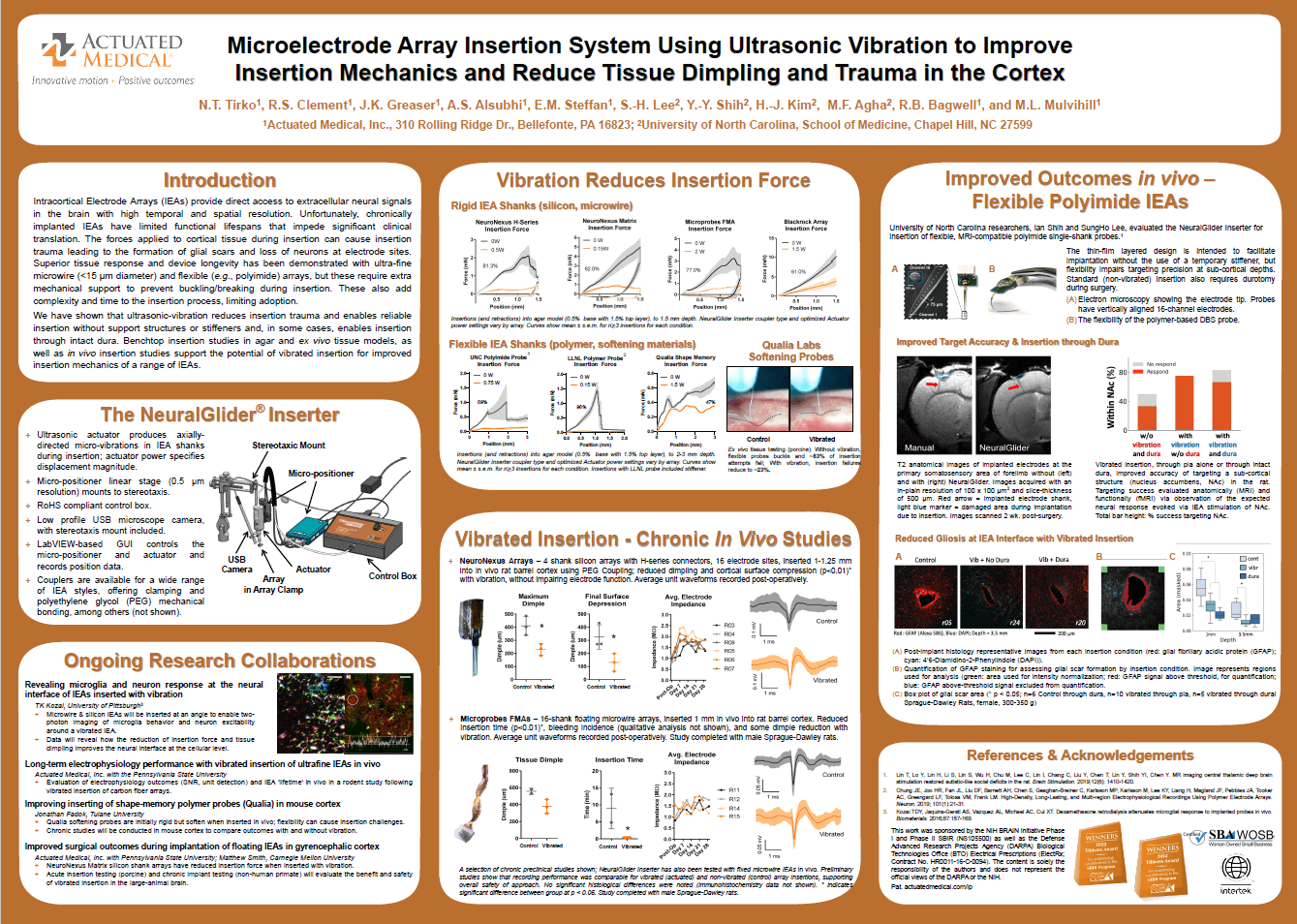Our Innovation, Your Research Breakthrough
PEDOT/CNT Flexible MEAs Reveal New Insights into the Clock Gene’s Role in Dopamine Dynamics
The Xinyan Tracy Cui lab at University of Pittsburgh developed new probes that can measure neuron activity and dopamine levels simultaneously. These techniques provided insight as to how circadian rhythms influence dopamine levels in mammals. These custom-made probes were optimized within the Cui lab, so when they used the NeuralGlider Inserter they were able to prevent dimpling and have a standardized and precise targeting in a brain center involved in reward and motor learning.
B. Wu, E. Castagnola, C. A. McClung, X. T. Cui, PEDOT/CNT Flexible MEAs Reveal New Insights into the Clock Gene’s Role in Dopamine Dynamics. Adv. Sci. 2024, 2308212. https://doi.org/10.1002/advs.202308212
Recording of pig neuronal activity in the comparative context of the awake human brain
In this groundbreaking study Juan Pascual at UT Southwestern and colleagues implanted penetrating electrodes into the brain of pigs to make specific comparisons to human brain activity. Because the team was using multiple probes that were as thin as 8 micrometers, they used NeuralGlider during implantation to measure the responses of individual neurons, minimizing damage and ensuring the longevity of these probes. NeuralGlider enabled them to implant in pigs, which are a low cost large animals, and this is a key step to get to first-in-human brain computer interfaces.
Dobariya A., El Ahmadieh T.Y., Good L.B., Hernandez-Reynoso A.G., Jakkamsetti V., Brown R., Dunbar M., Ding K., Luna J., Kallem R.R., Putnam W.C., Shelton J.M., Evers B.M., Azami A., Geramifard N., Cogan S.F., Mickey B., and Pascual J.M. Recording of pig neuronal activity in the comparative context of the awake human brain. Sci Rep, 12, 15503 (2022). https://doi.org/10.1038/s41598-022-19688-2
The effect of a Mn(III)tetrakis(4-benzoic acid)porphyrin (MnTBAP) coating on the chronic recording performance of planar silicon intracortical microelectrode arrays
Electrodes interfacing with neurons has a key challenge, in that the immune response reduces the signal over time. In this series of studies to optimize the long-term viability of electrodes, Jeffrey Capadona and his team at Case Western University coated electrodes with specialized bioactive molecules to minimize inflammation around the electrode. With NeuralGlider, this team was able successfully demonstrate that the MnTBAP enhanced electrode longevity.
Hernandez-Reynoso AG, Sturgill B, Hoeferlin G, Druschel LN, Krebs OK, Menendez DM, Thai TTD, Smith TM, Duncan J, Zhang J, Mittal G, Radhakrishna R, Desai MS, Cogan SF, Pancrazio JJ, Capadona JR. The effect of a Mn(III)tetrakis(4-benzoic acid)porphyrin (MnTBAP) coating on the chronic recording performance of planar silicon intracortical microelectrode arrays. Biomaterials. 2023, 303. https://doi.org/10.1016/j.biomaterials.2023.122351
Planar amorphous silicon carbide microelectrode arrays for chronic recording in rat motor cortex
With NeuralGlider, this team at UT-Dallas was able to insert electrodes as thin as 8 micrometers in diameter (1/10 the size of a human hair!) Implants lasted as long as 4 months.
Abbott JR, Jeakle EN, Haghighi P, Usoro JO, Sturgill BS, Wu Y, Geramifard N, Radhakrishna R, Patnaik S, Nakajima S, Hess J, Mehmood Y, Devata V, Vijakyakumar G, Sood A, Thai TTD, Dogra K, Hernandez-Reynoso AG, Pancrazio JJ, Cogan SF, Planar amorphous silicon carbide microelectrode arrays for chronic recording in rat motor cortex. Biomaterials. Volume 308, 2024.
Behavioral paradigm for the evaluation of stimulation-evoked somatosensory perception thresholds in rats
In this study, early career investigator award winner Ana Hernandez-Reynoso and her team at UT Dallas demonstrate how microstimulation can be used to improve sensory detection during an attention task. The NeuralGlider Inserter enabled them to implant thin recording and stimulating shanks measure brain activity during the task and during electrical microstimulation.
Chronic Stability of Local Field Potentials Using Amorphous Silicon Carbide Microelectrode Arrays Implanted in the Rat Motor Cortex
In this study, scientists developed custom made, ultrathin probes made of silicon carbide were compared to industry standard probes for longevity. Because of NeuralGlider they were able to insert ultrathin probes and record for up to16 weeks post implantation.
Influence of Implantation Depth on the Performance of Intracortical Probe Recording Sites
Because of NeuralGlider, Sourav S Patnaik and colleagues from UT Dallas successfully compared single shank and multiple shank probes. They discovered that electrode sites that are deeper don’t last as long as those that are shallower.
Reactive Amine Functionalized Microelectrode Arrays Provide Short-Term Benefit but Long-Term Detriment to In Vivo Recording Performance
The immune response reduces electrode usability over time. Jeffrey Capadona and his team at Case Western University coated electrodes with specialized bioactive molecules to minimize inflammation around the electrode. Due to NeuralGlider, this team was able successfully demonstrate that this reactive amine did not enhance electrode longevity.
In Vivo Characterization of Intracortical Probes with Focused Ion Beam-Etched Nanopatterned Topographies
This team used NeuralGlider to successfully minimize damage to insert custom made electrodes etched with gold and titanium into the brain. The yield using this custom etching extended electrode life by 4 weeks compared to industry standard.
Mechanically Robust, Softening Shape Memory Polymer Probes for Intracortical Recording
Engineers at UT Dallas created a new type of electrode array. Industry standard arrays are made from silicon, which can be brittle. So, the team led by Dr. Joseph Pancrazio used a novel shape memory polymer that is rigid at room temperature but softens in the brain. NeuralGlider successfully enabled the team to determine the superiority of shape memory polymer probes (which did not break) compared to industry standard silicon probes.
Characterization of Active Electrode Yield for Intracortical Arrays: Awake versus Anesthesia
The focus of this research group is to study the lifespan of specialized recording probes. NeuralGlider enabled the University of Texas at Dallas group to successfully test the effects of anesthesia on changes in neural activity from their specialized probes.
Real-Time assessment of rodent engagement using ArUco Markers: a scalable and accessible approach for scoring behavior in a nose-poking go/no-go task.
Researchers at UT Dallas and West Virginia collaborated to develop an automated assessment of animal behavior. With NeuralGlider, they were successfully able to implant stimulating and recording electrodes at 0.1 mm/s while actuated to their target location. Neural data will be published in an upcoming paper.
Low-Intensity pulsed ultrasound stimulation(LIPUS) modulates microglial activation following intracortical microelectrode implantation
Actuated Medical collaborated with a team at the University of Pittsburgh to develop a strategy to lengthen the lifespan of implanted electrodes. First, the Pittsburgh team used NeuralGlider to successfully implant fine electrodes. Then, using an acoustic device engineered at Actuated, the team at Pitt used gentle acoustic waves to reduce inflammation around the electrodes, lengthening the usability window of these implanted devices.
Posters

